
Most artists understand that we operate in a society that has devalued the thought processes essential to producing and appreciating art. Since the Enlightenment we have placed an emphasis on rational, analytical thinking and are often encouraged to distrust our intuition and feelings when making important decisions. Rather than nurturing, developing and training these vital human capacities we have for the most part starved them — relegating them to the fringes of meaningful human endeavor. So much of my work is about developing these capacities to better understand and explore our visual experience.
This is why you will rarely see my art displayed as a singular piece. Each piece is presented in an immediate context that allows one to make critical compositional observations, like the 3D set shown here.
I am amused when scientists seek to understand and describe the cognitive processes used by artists every day. Leonard Mlodinow’s book Elastic discusses the latest neurological – psychological research regarding how the brain processes information and makes decisions. In the introduction he discusses the three ways the brain works. The first two are fairly well-known and understood: scripted behavior, which is a short cut or fixed response the brain uses for routine situations, and analytical thought, a step-by-step approach based on facts or reason. Less is known about the third process, which he calls elastic thinking: It is non-linear and involves processing multiple lines of thought and diverse information.
All three of these thinking processes have played a significant role in human development. Mlodinow makes a case that, although analyticalthinking has been favored in modern society, elasticthinking will become increasingly important in the future.
He notes that elastic processes are unique to humans, and computers are incapable of processing information in the same manner. He also points out that in an age of accelerated change, uncertainty, globalization and rapid technological advances, elastic processing is an essential tool to thrive in today’s world. Elastic thinking is described by scientists as “bottom up,” proceeding largely from the unconscious, where conclusions are reached through interactions of billions of networked neurons in a process too complex to be taken step by step. Elastic thinking is useful for integrating diverse information and finding new approaches, and it fuels our imagination. Elastic thinking involves pattern recognition, divergent thinking, the ability to quickly generate ideas, and balancing and reconciling diverse or opposing views. Elastic thinking is the brain’s mechanism that allows us to respond effectively to novelty and change.
Sounds a lot like art.
